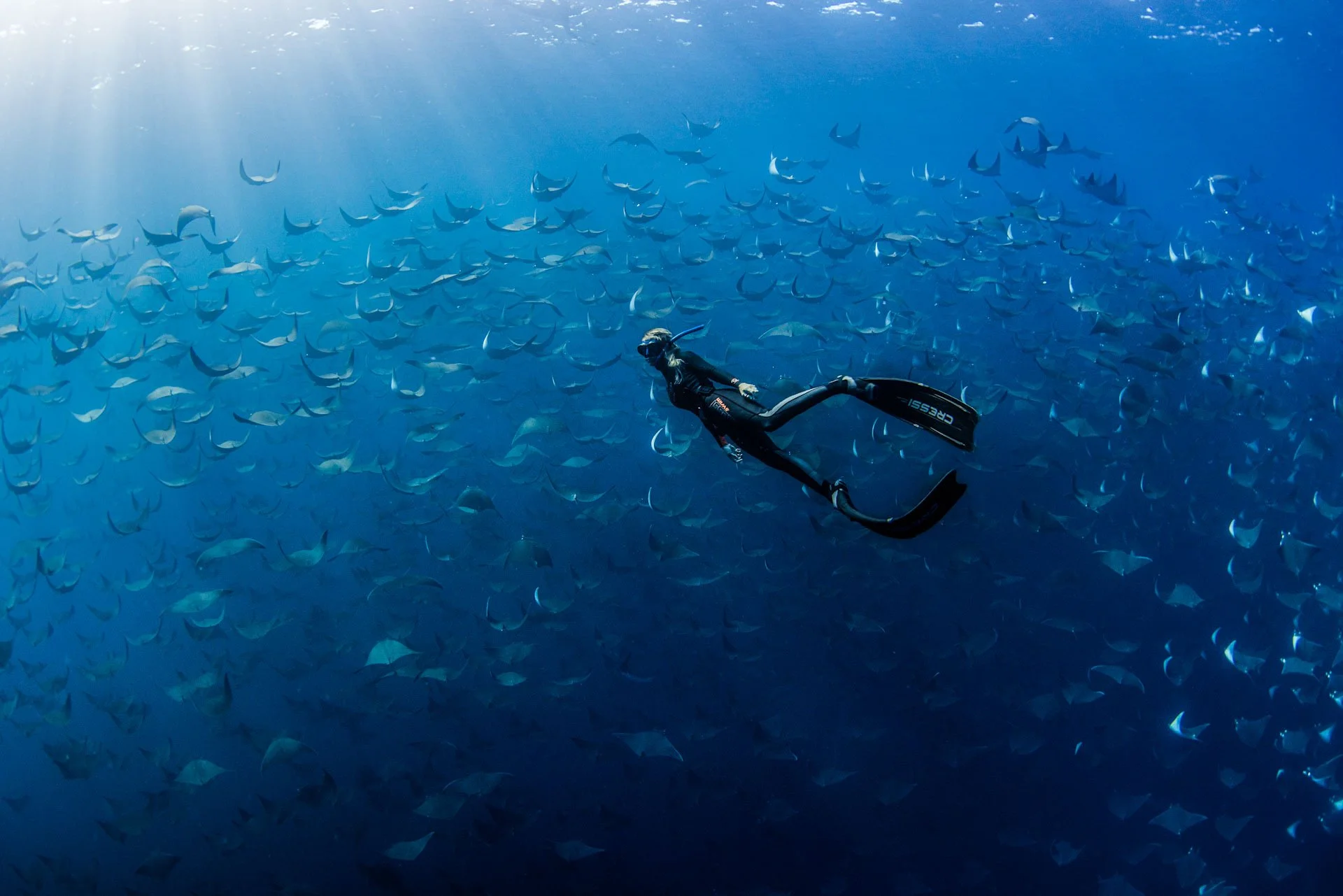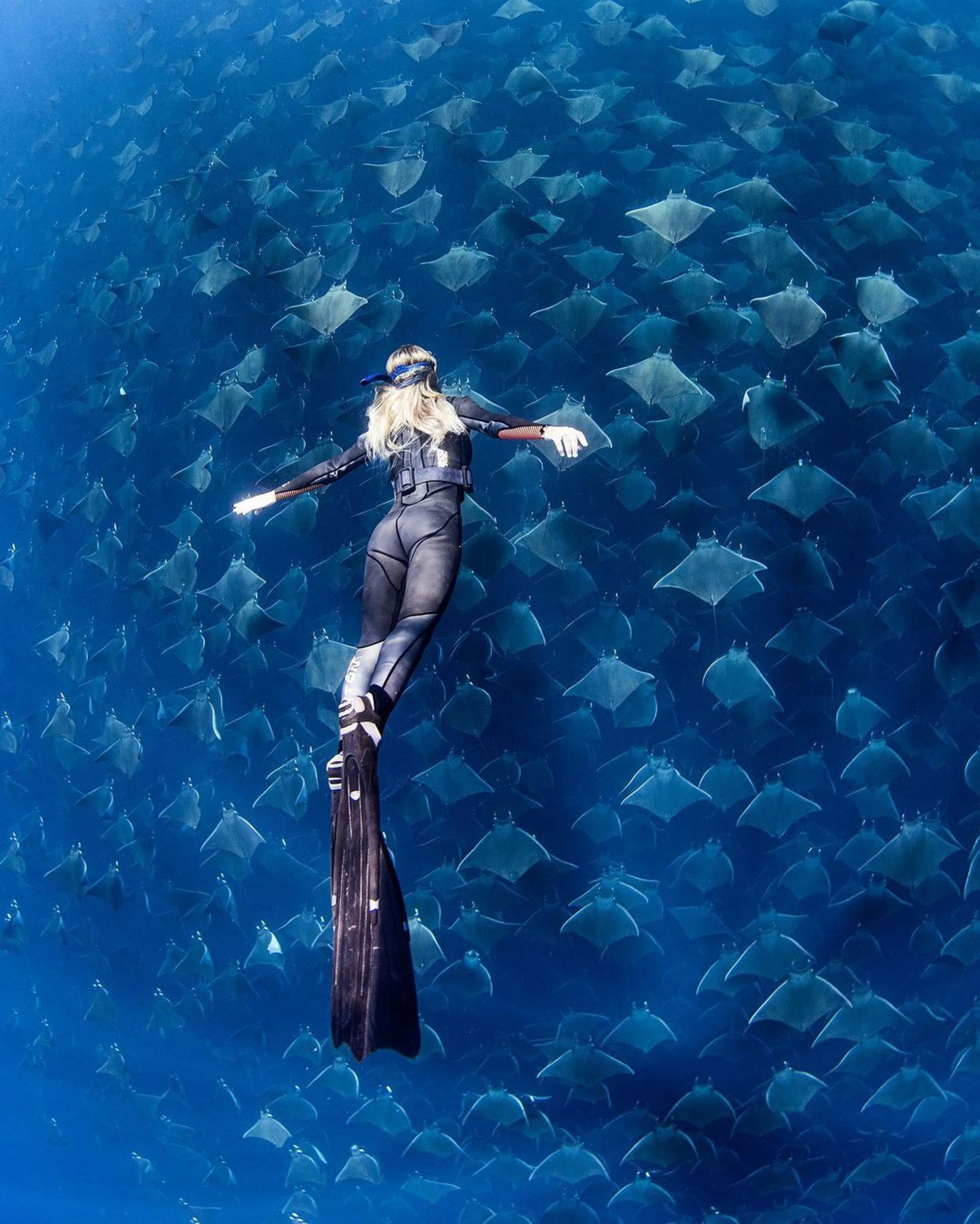Mobula season in Loreto Bay National Park: The Gulf’s most spectacular show has arrived!
Mobula rays aggregation in the Gulf of California
Spring and summer in Loreto mean one thing for ocean lovers: the mobula rays are back! Each year, these graceful creatures-often called “devil rays”-migrate through the Gulf of California (Sea of Cortez), and for a few magical months, Loreto Bay national park becomes the stage for one of the world’s most breathtaking wildlife events.
What’s So Special about mobula rays in Loreto?
Massive Schools:
From April to July, thousands of mobula rays (especially Mobula munkiana, and Mobula Mobular) gather off Loreto’s coast. These schools can be so large they stretch over a kilometer long, with rays leaping, flipping, and gliding through the water in a mesmerizing display.Acrobatic Displays:
Mobula rays are famous for their aerial antics. You might see dozens or even hundreds leaping up to 3 meters (9 feet) out of the water, sometimes in perfect succession. The sound of them landing is like popcorn popping on the ocean’s surface.Why do they gather?
Scientists believe these gatherings are for feeding, mating, and giving birth. Spring currents bring a feast of plankton to the surface, attracting the rays for both food and romance. Recent research even discovered that Baja’s coastline, including areas near Loreto, may serve as nursery grounds for young mobulas.A peaceful encounter:
Despite their nickname “devil ray,” mobulas are gentle and shy. They’re completely harmless to humans. Snorkeling or freediving-rather is the best way to see them up close, as bubbles from scuba gear can scare them away.
Regenerative Adventures in Loreto: Intimate encounters with Mobula Rays and marine megafauna
Are you ready to witness the magic of mobula rays and the incredible marine life of Loreto National Park? Join us for an unforgettable adventure with our regenerative tourism platform, proudly based in Loreto year-round. Our expeditions are led by a local captain who is not only a lifelong Loreto resident but also an engineer in fisheries, supported by two expert guides trained in wildlife handling and first emergency response-your safety and the animals’ well-being are our top priorities. We operate daily small-group expeditions throughout spring and summer, as well as immersive 5-day itineraries designed to encounter not just mobula rays, but also dolphins, sea turtles, and the seasonal giants of the Gulf like resident fin whales, orcas, and sperm whales that come to feed in these rich waters.
We believe in low-impact, high-quality experiences: our groups are limited to just 7 participants for shared adventures, and we offer private expeditions for those seeking personalized training, romantic escapes, or family-friendly outings-all with the utmost respect for wildlife. Our comfortable boat, La Puma, is equipped with ample shade and a restroom (a must for long days exploring the park and its islands). We provide everything you need: from light breakfast, healthy snacks, and lunch to all snorkeling gear and even high-quality photos, so you can focus on enjoying every moment.
Our 5-day itineraries cover the diverse and pristine areas of Loreto National Park, giving you a deeper perspective on why protected, healthy ecosystems matter-not just for wildlife, but for people and the planet. We strictly follow all regulations: our tours are fully permitted, our guides are certified, and we never promote illegal activities like plane-spotting for wildlife or swimming with whales. By choosing us, you support science, conservation, and the local community, ensuring these wonders remain for generations to come.
Why mobulas matter: The science behind the spectacle
Mobula rays aggregation in the Gulf of California.
It’s easy to get swept up in the magic of thousands of mobula rays soaring through Loreto’s blue waters, but did you know their presence is also a sign that this ecosystem is thriving? Here’s why:
Mobulas: Guardians of a healthy ocean
Mobula rays are filter feeders, gliding through the water with their mouths wide open to scoop up tiny plankton. These rays sit right in the middle of the ocean’s food web. Their abundance means there’s plenty of plankton-which in turn means the whole food chain, from the tiniest shrimp to the largest whales, is doing well. When you see mobulas, you’re seeing proof that Loreto National Park is a healthy, productive ocean.
Important fact:
Mobulas only have one baby every few years, making them especially vulnerable to threats. That’s why seeing them in large numbers is so special-it means the local environment is supporting their slow, careful way of life.
The spring and summer bloom: Nature’s buffet
So, why do mobulas show up in Loreto every spring and summer? It’s all about the ocean’s productivity. Here’s how it works:
Seasonal Currents:
In late spring, the Gulf of California is stirred up by changing winds and currents. These bring nutrient-rich waters up from the deep, a process called “upwelling.” According to scientific studies (see Palacios et al., 2024), this upwelling is strongest from December to May, but the effects linger into the warmer months.Plankton explosion:
The nutrients fuel blooms of plankton-tiny plants and animals that are the foundation of the ocean food web. Mobulas arrive right on cue, timing their migration to feast on this natural buffet.A chain reaction:
Where there’s plankton, there are mobulas. Where there are mobulas, there are bigger predators-like dolphins, sea lions, and even orcas. In fact, orcas sometimes visit Loreto’s waters during mobula season, hunting the rays in dramatic chases that are thrilling for lucky wildlife watchers.
Orcas in Loreto Bay National park
Loreto: A living laboratory
Scientists love Loreto because it’s a perfect place to study incredible species and the ecosystem that supports them. The presence of mobula rays here tells us:
The water is clean and rich in nutrients.
The food chain is intact, from plankton to top predators.
Conservation efforts in Loreto National Park are working!
The recent scientific paper by Palacios et al. (2024) highlights that while the most intense mobula reproductive activity is concentrated further south, Loreto Bay National Park is part of a network of protected areas crucial for the survival of these endangered species. The park’s healthy conditions allow for these amazing seasonal gatherings and support the entire marine food web.
When and how to see them
Mobula rays aggregation in the Gulf of California with our wildlife expedition guide Regina Domingo.
Best time:
Late April through July is prime mobula season in Loreto. Early mornings are often best for calm water and active rays.What to expect:
Our expeditions head out at sunrise, searching for the telltale splashes of jumping rays. Once a school is spotted, you’ll have the chance to gently slip into the water and float above or alongside these elegant animals.Other wildlife:
The Gulf of California is famously called “the aquarium of the world.” Alongside mobulas, you might spot dolphins, sea lions, whales, and-if you’re lucky-even orcas, which sometimes visit Loreto’s waters to hunt rays.
Conservation and science
Mobula rays are vulnerable due to their slow reproduction (one pup every few years) and threats from fishing. Loreto National Park is a critical safe haven for them, and local scientists-like Marta Palacios, who helped discover the first mobula nursery ground-are working hard to learn more and protect these incredible animals. Responsible tourism and citizen science projects are helping fill in the gaps about their mysterious lives.
Tips for your Mobula adventure in Loreto (or other locations)
Making the most of your mobula experience means not only enjoying the spectacle, but also helping to protect these magnificent rays and the ecosystem they call home. Here’s how you can do it right:
1. Choose responsible, permitted operators
Tourism permits matter: Only book with tour operators who have the proper government permits to operate inside Loreto National Park or other areas. These permits are required by Mexican law and ensure your activities are legal and regulated.
Certified and trained guides: Look for companies whose guides are certified in wildlife handling, first aid, and emergency response. Experienced guides know how to keep both you and the mobulas safe, and can respond quickly if there’s an emergency on the water.
2. Support science and conservation
Choose operators who give back: Some tour companies actively support scientific research and conservation programs-by sharing sightings, collecting data, or funding local projects. Ask your operator how they contribute to conservation!
Citizen science: Your observations can help! Some tours partner with scientists to collect photos or data on species sightings, helping to protect these rays for future generations.
3. Say no to illegal or harmful activities
No Plane Spotting for Wildlife: In Mexico, using planes to spot and chase marine wildlife for tourism is strictly prohibited. Avoid any operator offering these services.
No swimming with whales: Swimming with whales is illegal in Mexico and can disturb these protected animals. If you see this advertised, steer clear.
Respect the rules: Responsible operators will brief you on rules and wildlife codes of conduct. Always listen and follow their instructions.
4. Prioritize low environmental impact
Our boat cruising Loreto National Park in search of Mobula rays aggregations.
Avoid crowds and mass tourism: Smaller groups mean less disturbance to wildlife and a more intimate, enjoyable experience for you. Choose operators who limit group sizes and avoid overcrowded sites.
Respect wildlife space: Enter the water quietly, never chase or touch the rays, and always keep a respectful distance. Let the mobulas come to you!
Diversity is key: Explore different areas and times-not just the busiest hotspots. This spreads out visitor impact, supports local communities, and can lead to unique encounters.
5. Gear and attitude
Mobula rays aggregation in the Gulf of California with our wildlife expedition guide Regina Domingo.
Bring a Snorkel, Not Scuba: Mobulas are easily spooked by bubbles. Snorkeling is the best way to observe them up close without causing stress.
Be patient and respectful: Sometimes the rays are shy or deep. Enjoy the sunrise, the sea, and the anticipation-nature works on its own schedule!
Safety first: Listen to your guide’s safety briefing and always wear the provided safety gear. Remember we are in the ocean and there is other wildlife like orcas and sharks.
6. Why this matters
By choosing responsible, legal, and conservation-minded operators, you help ensure that mobula rays-and the entire Loreto and Gulf of Califotnia ecosystem-remain healthy and vibrant for years to come. You’ll also have a safer, more meaningful, and unforgettable adventure.
Remember:
Your choices as a traveler make a real difference. By supporting ethical or regnerative tourism, you’re protecting species supporting local communities, and making your own experience more magical. Fewer boats, smaller groups, and respect for wildlife mean more intimate encounters and a healthier ocean for all!
Ready for summer 2025 in Loreto?
If you’re visiting Loreto in spring or early summer, don’t miss this natural spectacle. Floating among a swirling, shimmering school of mobula rays is a once-in-a-lifetime experience-one that will leave you awestruck and inspired to protect the wonders of our ocean.
Ready to witness the magic? Choose wisely, and enjoy every moment with these incredible rays!
Mobula rays aggregation in the Gulf of California with our wildlife expedition guide Regina Domingo.







